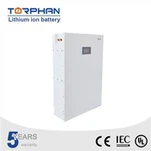LiFePO4 Solar Storage Battery
Introduction
Much like your cell phone, you can charge your lithium iron phosphate batteries whenever you want. If you let them drain completely, you won’t be able to use them until they get some charge. Unlike lead-acid batteries, lithium iron phosphate batteries do not get damaged if they are left in a partial state of charge, so you don’t have to stress about getting them charged immediately after use. They also don’t have a memory effect, so you don’t have to drain them completely before charging.
As a default, LFP chemistries’ useful life can range between 3,000 to 5,000 cycles. However, with opportunity charging, that can be increased significantly, anywhere up to 7,000 cycle count. Whereas lead-acid shouldn’t be charged until it’s depleted to 20% battery capacity, Lithium-ion batteries thrive on what it calls opportunity charging. While the two types—LFP and NMC—operate similarly, there are some differences.
Besides looking for the right energy sources based on portability, safety and energy density, manufacturers also must consider the costs during the production of electronics as well as during disposal. Many manufacturers will select lithium iron phosphate as the cheaper battery alternative. The batteries cost less due to the safer iron phosphate chemistry as manufacturers don't have to spend more money to recycle the materials.
Advantage
High working voltage
Long life cycle
Low self-discharging
Application
RVS
Residential Energy Storage
Off-grid
Service
OEM
Hot Tags: lifepo4 solar storage battery, China, suppliers, manufacturers, factory, buy











